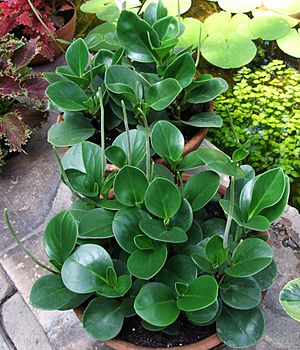Baby rubberplant facts for kids
Quick facts for kids Baby rubberplant |
|
|---|---|
 |
|
| Scientific classification | |
| Genus: |
Peperomia
|
| Species: |
obtusifolia
|
The Peperomia obtusifolia, also known as the baby rubberplant or pepper face, is a cool flowering plant. It belongs to the family called Piperaceae. You can find it growing naturally in Florida, Mexico, and the Caribbean. Its scientific name, obtusifolia, means "blunt-leaved," which describes its leaves. This plant is so nice that it even won an award from the Royal Horticultural Society!
Contents
About the Baby Rubberplant
This plant is an evergreen perennial, which means it stays green all year and lives for many years. It can grow up to about 25 centimeters (10 inches) tall and wide. Its leaves are thick and leathery, shaped like little cups. The plant also grows narrow spikes of white flowers. These flowers can be up to 12 centimeters (5 inches) long. They grow in a shiny, winding way, adding a lot to the plant's beauty.
How to Care for Your Peperomia
The baby rubberplant is a popular houseplant because it's pretty easy to care for. It needs a minimum temperature of about 15°C (59°F). This means in most cooler places, you'll need to grow it indoors.
Even though it likes a bit of humidity, it doesn't need constant fussing. Just make sure it gets good light. Not too much direct sunlight, though! Too much sun can make its leaves lose their bright color. Average light is usually perfect.
Its leaves and stem are thick and fleshy. This means they store water, so you don't need to water it very often or give it a lot of water at once. In the summer, you can give it some liquid plant food every two weeks to help it grow strong. Many different types of this plant have been grown. Some even have cool patterns or different colors on their leaves, which is called variegation.
Keeping Your Plant Healthy
Generally, the baby rubberplant is a tough plant. But, like many plants, it can sometimes get tiny bugs. These include aphids and mealybugs. You can usually spot them and treat them easily.
The biggest problem for this plant is too much water. Giving it too much water can cause its roots to rot. So, remember, less is more when it comes to watering your Peperomia!
Gallery
See also
 In Spanish: Peperomia obtusifolia para niños
In Spanish: Peperomia obtusifolia para niños






